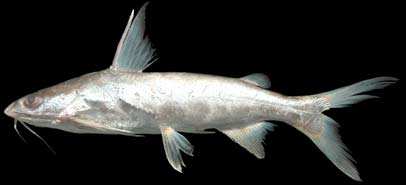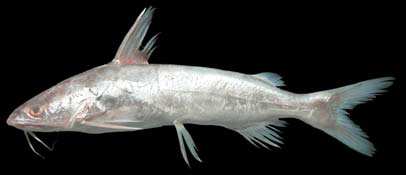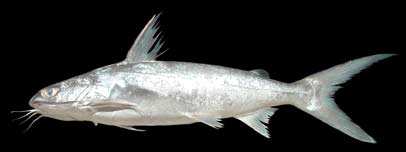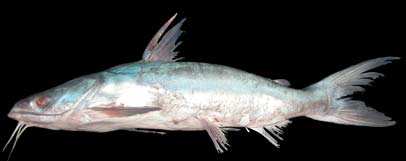ARIIDAE
Sea Catfishes
By Seishi Kimura
 Arius oetik |
 Arius venosus |
 Arius species |
 Nemapteryx nenga |
 Netuma thalassinus |
 Plicofollis nella |
|
Medium to large sized marine and freshwater catfishes; maximum size about 1.8 m. Body elongated, robust; head depressed but tail compressed. Bony shield dorsally on head usually visible, with a dorsomedian grove, extending posteriorly to nuchal bone. Snout pointed or rounded anterior and posterior nostrils close together; mouth terminal or inferior. Jaw teeth small, arranged into narrow or broad bands; palatal teeth on small or large patches. One, two, or three pairs of barbels present around the mouth; no nasal barbels. Gill membranes joined together and attached isthmus anteriorly. Branchiostegal rays 5 to 7. Dorsal fin with a long, robust, usually serrated spine followed by 7 branched rays; a very small spinelet or buckler present prior to dorsal spine; anal fin with 14-36 soft rays; caudal fin deeply forked with 15 (7+8) principal rays; pectoral fins low on the sides of body with a usually long and serrated spine and 7-13 branched rays; pelvic fins abdominal with 6 branched rays; adipose fin present just above anal fin. Body naked; lateral line well developed. Color: body dark, brownish dorsally, silvery ventrally; adipose fin with a black spot in some species. Similar families occurring in the area. Ariidae is distinguished from other Indo-Pacific catfish families in having a long, usually serrated dorsal fin spine, deeply forked caudal fin, short-based anal fin, adipose fin just above anal fin, naked body, and no nasal barbels. Plotosidae: caudal fin confluent with long-based anal fin; no adipose fin; nasal barbels present. Bagridae (freshwater): nasal barbels present. Siluridae and Clariidae (both freshwater): nasal barbels present; no dorsal fin spine; long-based anal fin. Pangasidae (freshwater): long-based anal fin. Remarks. Occurring in tropical to temperate marine, estuarine, and freshwater areas of the world, usually found in coastal and estuarine habitats, abundant in mangrove areas and large river estuaries. Omnivorous, usually feed on crustaceans, mollusks, and fishes. Males incubating the fertilized eggs in his mouth cavity. Food fish. |

|
|